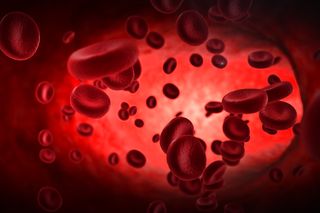Why Humans Hate the Scent of Blood (But Wolves Love It)

The coppery scent of fresh blood is known to attract predators. And now, scientists have pinpointed a molecule in mammal blood that plays a pivotal role in luring some types of animals and actively repelling others, including humans.
Researchers recently took a closer look at a single compound from mammal blood's complex chemical cocktail, and they discovered that certain blood-seeking predators responded to it with the same eagerness that they would demonstrate for blood itself.
At the same time, the researchers found that the presence of the compound strongly repelled prey animals. Further tests showed that humans also showed aversion to the blood molecule, making this the first known chemical signal to affect people as well as nonhuman animals. [Is It Safe to Drink Blood?]
The human nose can identify more than 1 trillion scents, though it doesn't come close to some of the supersniffers in the animal kingdom. Elephants have about five times as many genes that are associated with smell as humans do, while dogs' noses are so sensitive that they can detect odors associated with certain human cancers. And seabirds navigate from on high using "odor maps" of the landscape below, researchers discovered in 2015.
But regardless of animals' olfactory prowess, something about the blood chemical known as trans‐4,5‐epoxy‐(E)‐2‐decenal — or E2D — sparked similar responses of attraction and repulsion across a selection of different species, according to a new study.
Urine, feces and body odors all produce scents that attract or repel predators and prey. But there are hundreds of molecules that make up these smells, and the responses they elicit are often species-specific, the scientists wrote in the study. This means that a predator would likely react strongly to these smells if they came from an animal that it typically hunted, while a predator that fed on different prey might not respond at all.
Bad blood
Blood, however, appears to trigger a more universal response in animals: It attracts predators and repels prey. The researchers wondered if they could determine which chemical in blood was driving this reaction, so they tested E2D on a range of species for the first time.
Sign up for the Live Science daily newsletter now
Get the world’s most fascinating discoveries delivered straight to your inbox.
They studied the stable fly (Stomoxys calcitrans) — a pest insect that feeds on livestock blood — and found that it was as attracted to E2D as it was to actual blood. The Eurasian wolf (Canis lupus) responded avidly to logs scented with E2D — again, responding just as it did to logs rubbed with blood, the researchers reported.
But E2D was a switch-hitter, sending a come-hither signal to predators while signaling prey to steer clear. The scientists found that mice (Mus musculus) avoided scented compartments treated with E2D, just as they avoided compartments treated with blood.
Interestingly, E2D triggered a similar repulsion in humans. Study participants stood on a force plate, which measured their responses to 2-second puffs of odors delivered through a nozzle. When E2D was present, the subjects recoiled, and sensors detected increased perspiration in their palms — both of these responses demonstrate aversion, according to the study.
"E2D seems to activate our entire general defense system," lead study author Artin Arshamian, a postdoctoral researcher with the Department of Clinical Neuroscience at the Karolinska Institute in Sweden, said in a statement.
But why would people respond to the smell of blood as though they were prey? The researchers suspected that this reaction stemmed from the molecule's evolutionary origins. The E2D compound may have emerged so early in the human lineage that it dates back to our earliest primate relatives: insect eaters that were preyed upon by other animals, Arshamian explained.
"Modern humans are without doubt predators, but we probably evolved from a prey species, and some aspects of this characteristic remain," he said.
The findings were published online Oct. 20 in the journal Nature: Scientific Reports.
Original article on Live Science.

Mindy Weisberger is an editor at Scholastic and a former Live Science channel editor and senior writer. She has reported on general science, covering climate change, paleontology, biology, and space. Mindy studied film at Columbia University; prior to Live Science she produced, wrote and directed media for the American Museum of Natural History in New York City. Her videos about dinosaurs, astrophysics, biodiversity and evolution appear in museums and science centers worldwide, earning awards such as the CINE Golden Eagle and the Communicator Award of Excellence. Her writing has also appeared in Scientific American, The Washington Post and How It Works Magazine.

